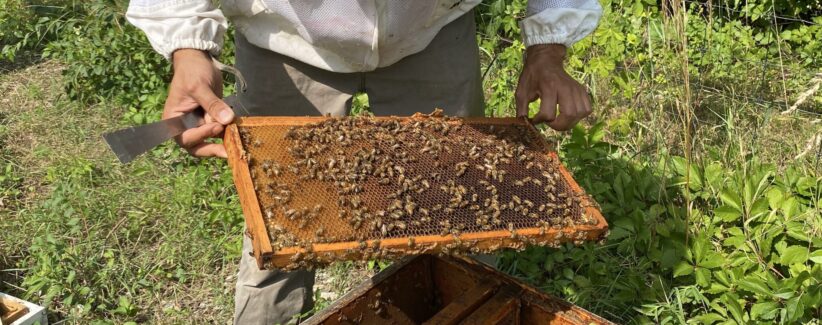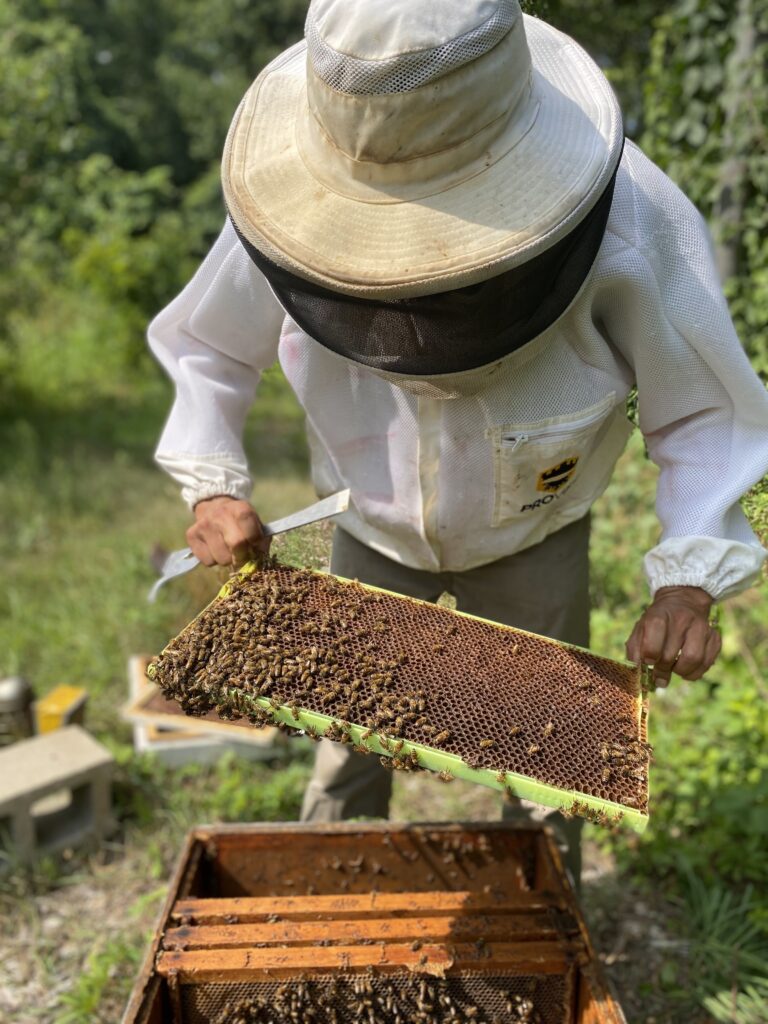Catching up with Beekeeper David Salomón Saleh

When David Salomón Saleh took over managing Gaining Ground’s bee colonies, the Colombia native hoped to learn more about sustainable agriculture and beekeeping in the northern hemisphere. Lesson one: Success would not come easy.
“Gaining Ground was having trouble keeping the bees alive over the winter and even during the season,” David says. “They had to buy new bees and sometimes equipment every year.”
Opportunistic pests, viruses, and bacterial diseases plagued the colonies. David had to disinfect and start over, and just when he started seeing success, the COVID-19 pandemic, made it harder to manage the bees and after about 50% died Saleh faced another near-restart.
Today, David manages four separate bee colonies each with about 50,000 bees. The bees serve as key cogs in a biodiverse ecosystem helping to pollinate plants and flowers and providing honey. David discussed his journey with Gaining Ground, from hardships to success, clears up a common myth and more.

GG: What has recovery for the hives looked like?
DS: Every time I check on the hives, I make observations, track the estimated number of bees, check the colony’s weight and select which colonies where I want to make queens. Based on those observations over the past years I’ve been selecting the hives that we can make to be the strongest they can be, especially in terms of resilience for pathogens so they don’t need treatment. We now have four separate colonies now — one per hive.
GG: What types of products do honey bees produce?
DS: Honey is one. It’s very complex and
has enzymes, minerals, vitamins and several other bioactive compounds essential for bees. Pollen is another. Hives have secretion and transformation products. Honey, pollen, propolis are products made from what bees collect in the environment. Secretion products such as bees wax, royal jelly are products that bees produce from their bodies. We don’t harvest the pollen because it’s time-consuming, but people do eat it— it’s a little sweet.
GG: What does fall bring for honey bees?
DS: Fall is the moment when there are not many resources available for bees. At the end of the summer, when it’s very dry, you can see the stress in the colonies. There’s an overlap with pests—even multiple pests—which are at a point in the life cycle where they reach their peak presence within a colony.
GG: How do you try to reduce the impact of these pests as much as possible?
DS: It begins during the summer. It’s very important, starting in the summer, to thoroughly check for pests and diseases. I implemented an Integrated Pest Management program that lets me track and intervene when needed. When I intervene, I first use some genetic selection. I try to breed the bees that are happier and have adapted to my management and the location. I also remove frames to clean them. Sometimes I’ll put them in the freezer, where the pests will die and then put them back. If I see the pests are still growing in August or September, I intervene with medication. I use organic acids and essential oils. In the past, I used synthetic treatments. But I realized that it’ll be effective for one season but then the pests become resistant.
GG: What benefits do bees bring to a biodiverse ecosystem?
DS: Honeybees have become an important pillar in the development of agriculture in the U.S. But they are not native— they came from Europe and brought many things like seeds for grasses we use to feed cattle to the ecosystem.
The bees native to America are focused on specific native plants, so the only way the grasses expanded so broadly across the country is because they had European honeybees as pollinators. The honeybees can travel three miles around, so they’re efficient at pollinating one or two species of crops in the short period that farmers have a window for blooming — watermelon, blueberries and especially almonds, which is a huge industry.
Nowadays there is evidence that native bees and honey bees do not compete for resources and can work together to pollinate more efficiently a big diversity of plants in the landscape.
GG: Last question: What bee myth would you like to debunk?DS: Wasps are not bees and wasps really aren’t defensive. They’re not going to attack anybody. Wasps have an important task — they eat insects that are not beneficial, and they pollinate some plants. Yellow Jackets are different from wasps. They are really carnivores and eat all insects. My experience with yellow jackets is that they’re annoying and kind of unbearable. So, it’s better to move yellow jackets out than wasps. Of course, I understand if you have children or it’s next to a working area, you may want to move both.